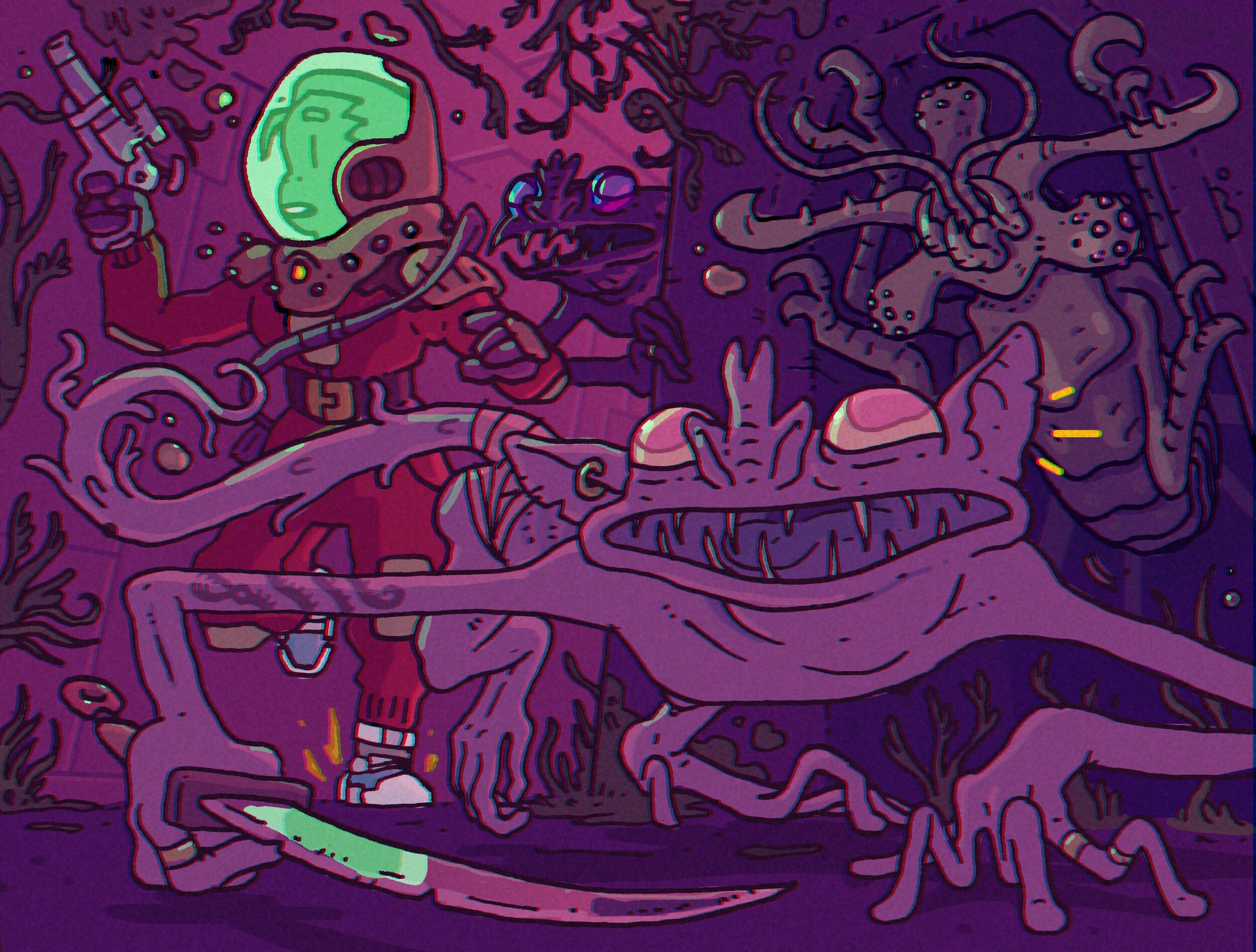Anti Canon Ancestry II: There Be Goblins!
Throughout this article, I’ll be showcasing some of my favorite #GoblinWeek art I saw this week. This and the one for the thumbnail are from Drew Shields, who is @thegnarlyghost on twitter!
It’s #GoblinWeek! I am, unfortunately, not much of an artist so my contribution is detailing how goblins fit into the Prismatic Wasteland. This wasn’t something I’ve addressed in my in-progress rules or setting guide, so this is equal parts challenge and thought experiment. This post follows up on my earlier post on ancestry, which discusses those staple ancestries of fantasy and how I incorporate them into the Prismatic Wasteland. My first thought was that goblins, like orcs or elfs, are yet another flavor in the Neapolitan ice cream that is humanity in the post-post-apocalyptic future. But, that is just boring and far too easy.
Art by @Ramonkey_art on twitter. Check out his web comic!
Goblins are an alien meta-species. Like humanity, they expanded across the stars, developed a variety of cultures and phenotypes. Unlike humanity, they hail from some far-flung planet on a distant star. The goblins in the Prismatic Wastelands are just the descendants of those left behind on the continent of Ro on the planet that was once Earth. This might be a good time to bring up the continent of the Prismatic Wastelands, Ro.
Art by Me (I mentioned I’m not an artist, right?)
Ro is a supercontinent that resembles the letters R and O pressed together. Ro was created by an impossibly ancient and advanced pangalactic empire that mastered planetary engineering. A member of this ancient civilization used the planet we call Earth as an elaborate prom-posal whereby the planet’s continents were shifted to spell out “Prom?” The intended recipient declined. Over the eons, the continents have shifted somewhat, and Ro, if viewed from above, has a vaguely cranial appearance.
Goblins are not a monolith. In fact, not all goblins are goblins. There are retro-goblins, those closest in resemblance to today’s goblins (as they exist in a far-away solar system), hobgoblins, bugbears and nilbogs. There is no more of a pan-goblin culture than there is a pan-human culture, and even among the subgroups, there are all sorts of ways goblins identify. Bugbears and hobgoblins are just as likely to view each other as kin as are dwarfs and elfs. As I stressed in part I, there are no mechanical impact of ancestry. I prefer to avoid bioessentialism, please and thank you. Like with humans, players with goblin characters get to determine what this ancestry is like, aided by rolling on the below table:
| 1d6 | 1-3 | 4-5 | 6 |
|---|---|---|---|
| Retro Goblins | Far Travelers. Their home planet had a lower threshold for abuse than Earth, motivating earlier space travel. They toured the galaxy before humans landed on the moon. | Logicians. To prevent the irrational use of ancient combat rituals, they developed a sacred devotion to logic and reason and expelled those clinging to guns or god. | The Empire. A holy war swept the galaxy, and those responsible claimed totalitarian control. Soon, the emperor became an unspeakable monster, which is typical. |
| Hobgoblins | Clone Army. They were bioengineered to be perfect soldiers in a galactic civil war. They were such great soldiers that they kept fighting long after they won the war. | Overlords. Through superior force of arms and an honor-bound devotion to violence, they crushed their enemies into submission. They cannot be negotiated with. | Galactic Patrol. They are a cosmic police force that maintains law and order. Their primary mandate is to enforce a strict law against the use of time travel in the galaxy. |
| Bugbears | Space Pirates. Exiled from their home planet, they put their talents to use by ambushing cosmic boxcars or burglarizing planets using their makeshift space galleons. | Gladiators. After many eons of galactically-syndicated gladiatorial combat on a remote planet, the best fighters begat better fighters until they escaped the planet. | Elite Troops. A harsh prison planet develops fierce, hardened goblins. The fiercest and most hardened became the personal fighting force for a corrupt emperor. |
| Nilbogs | Living Plants. Descended from carnivorous plants capable of mimicking prey, they are now identical to goblins. It is easier to devour an unsuspecting retro goblin. | The Collective. After the molecular machine injection, a goblin host begins cybernetic assimilation. When goblin colonies go missing, fear spreads. Resistance is futile. | Gremlins. Born beneath a full moon lit by a dying sun, they seem like their retro goblin parents. But if they eat after midnight, they become bloodthirsty monsters. |
Goblins lean more in the science direction within this science fantasy setting. A lot of these are “inspired” (i.e., lovingly ripped off) from science fiction classics. Because each goblinoid ancestry is “alien”, i.e., not immediately tied to Earth, I would definitely have more follow up questions for a player with a goblin character about how their family or ancestors arrived on Ro. Their answer would also help inform how I use goblins throughout the campaign; are goblins rare because a few goblins were stranded here centuries ago or are they prevalent because of mass migration of goblins millennia ago? When I ask players questions, I like to meaningfully incorporate their answers into the setting. This is something I picked up from running more narrative games like Dungeon World, but I don’t think it should be taboo in OSR-style play. The great thing about this type of collaboration is that the players immediately know a lot more about the setting than they would otherwise. This is much more effective than trying to get players to read setting material (gross).
Art by @cosmignon on twitter. More of her art on her website!
I hope everyone had a happy Goblin Week!
Art by @Alaingruetter on twitter. They have lots of goblins you can buy here!






